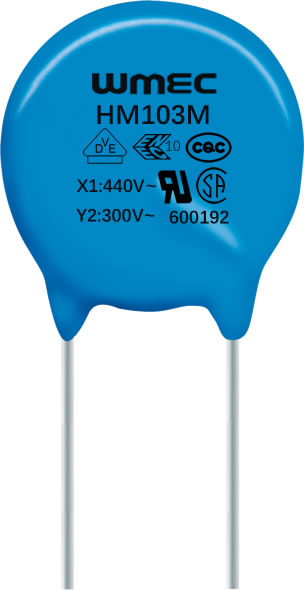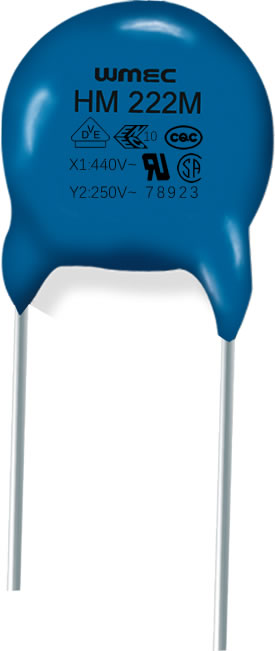Rated Voltage : X1:AC400V,Y1:AC250V
Capacitance : 100PF-4700PF
TC : B,E
Both X and Y capacitors are safe capacitors, the difference is that the X capacitor is connected to the input line to eliminate the differential mode interference. The Y capacitor is connected between the input line and the ground wire to eliminate the common mode interference;
X CBB high voltage capacitor capacitor with square plastic, CBB capacitor not only has better electrical performance, and input in parallel with power can effectively reduce the influence of high frequency pulse power switch.
Y, a high voltage ceramic capacitor. Y type capacitor is connected between phase and ground. In order not to exceed the allowable leakage value of the ground wire defined by the relevant safety standards, the values of these capacitors are about nF. In general, the Y capacitor should be connected to a wire with a large noise interference;
Y capacitor is divided into Y1 capacitors and Y2 capacitors, Y1 is a double insulated Y capacitor, used to cross the one or two side of the.Y2 is a basic single insulation Y capacitor, used to cross the primary side of the earth to protect the FG line.
An adjustable capacitor is used for such occasions, that is, after the capacitor failure, will not cause electric shock, does not endanger personal safety
Peak pulse voltage overvoltage rating (IEC664) allowed in X safety capacitor level applications
X1 >2.5kV = 4.0kV SW {{
X2 = 2.5kV IY-F 6bXV
X3 = 1.2kV}_.T.S@; 9e
Y safety capacitor safety rating insulation type rated voltage range
Y1 double or reinforced insulation is greater than or equal to 250V
Y2 basic insulation or 150V = 250V = supplementary insulation
Y3 basic insulation or 150V = 250V = supplementary insulation
Y4 basic insulation or additional insulation <150V
X capacitor suppressed differential mode interference
Y capacitance suppresses common mode interference
According to IEC 60384-14, capacitors are divided into X capacitors and Y capacitors,
1 X capacitor is a capacitor across the L-N.
2 Y capacitor is a capacitor across the L-G/N-G. (L=Line, N=Neutral, G=Ground).
(1) the most important purpose of Y-CAP is to EMI
(2) now most people do not want to add Y-CAP, there are two points:
A. is to reduce costs, a Y-CAP has 0.3RMB, and now we are in the design of NO Y
B. our switching power supply in a number of audio equipment used when there are many problems, such as MP3 switching power supply is not a good linear power supply, fixed station phone, ADSL switching power supply will have noise;
3 safety regulations on the Y-CAP did not say that we must add, as long as you can go over the EMI, Y-CAP too general impact of leakage current
The X capacitor is divided into X1, X2, X3, the main difference is that: 1 X1 high pressure greater than 2.5 kV and less than or equal to 4 kV, 2 X2 high voltage is less than or equal to 2.5 kV, 3 X3 high voltage is less than or equal to 1.2 kV Y capacitor is divided into Y1, Y2, Y3, Y4, the main difference is that: 1 Y1 high voltage more than 8 kV, 2 Y2 high pressure greater than 5 kV, 3 Y3 n/a 4 Y4 high voltage high voltage is greater than 2.5 kV. Then the "X1 400V, Y1 250V on behalf of X parameters when capacitance: pressure is greater than 2.5KV, the maximum working voltage should not exceed 400V; parameters for Y capacitance to voltage greater than 8KV, the maximum working voltage should not exceed 250V. so you can choose the appropriate capacitor.
The capacitor 250V can replace high voltage ceramic capacitor 3KV. But the high voltage ceramic capacitor can not replace the capacitor, because there is no safety certification.







